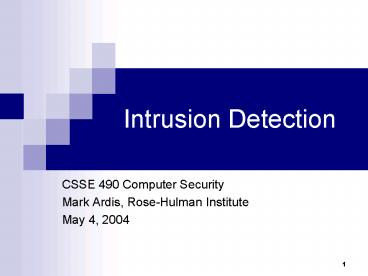Intrusion Detection - PowerPoint PPT Presentation
1 / 16
Title:
Intrusion Detection
Description:
Many of these s came from Chris Clifton and Matt Bishop, ... Intrusion Detection Expert System (IDES) successor is NIDES. Network Security MonitorNSM ... – PowerPoint PPT presentation
Number of Views:91
Avg rating:3.0/5.0
Title: Intrusion Detection
1
Intrusion Detection
- CSSE 490 Computer Security
- Mark Ardis, Rose-Hulman Institute
- May 4, 2004
2
Acknowledgements
- Many of these slides came from Chris Clifton and
Matt Bishop, author of Computer Security Art and
Science
3
Intrusion Detection/Response
- Characteristics of systems not under attack
- Actions of users/processes conform to
statistically predictable patterns - Actions of users/processes do not include
sequences of commands to subvert security policy - Actions of processes conform to specifications
describing allowable actions - Denning Systems under attack fail to meet one
or more of these characteristics
4
Intrusion Detection
- Idea Attack can be discovered by one of the
above being violated - Problem Definitions hard to make precise
- Automated attack tools
- Designed to violate security policy
- Example rootkits sniff passwords and stay
hidden - Practical goals of intrusion detection systems
- Detect a wide variety of intrusions (known
unknown) - Detect in a timely fashion
- Present analysis in a useful manner
- Need to monitor many components proper
interfaces needed - Be (sufficiently) accurate
- Minimize false positives and false negatives
5
IDS TypesAnomaly Detection
- Compare characteristics of system with expected
values - report when statistics do not match
- Threshold metric when statistics deviate from
normal by threshold, sound alarm - E.g., Number of failed logins
- Statistical moments based on mean/standard
deviation of observations - Number of user events in a system
- Time periods of user activity
- Resource usage profiles
- Markov model based on state, expected
likelihood of transition to new states - If a low probability event occurs then it is
considered suspicious
6
Anomaly DetectionHow do we determine normal?
- Capture average over time
- But system behavior isnt always average
- Correlated events
- Events may have dependencies
- Machine learning approaches
- Training data obtained experimentally
- Data should relate to as accurate normal
operation as possible
7
IDS TypesMisuse Modeling
- Does sequence of instructions violate security
policy? - Problem How do we know all violating sequences?
- Solution capture known violating sequences
- Generate a rule set for an intrusion signature
- But wont the attacker just do something
different? - Often, no kiddie scripts, Rootkit,
- Alternate solution State-transition approach
- Known bad state transition from attack (e.g.
use petri-nets) - Capture when transition has occurred (user ? root)
8
Specification Modeling
- Does sequence of instructions violate system
specification? - What is the system specification?
- Need to formally specify operations of
potentially critical code - trusted code
- Verify post-conditions met
9
IDS Systems
- Anomaly Detection
- Intrusion Detection Expert System (IDES)
successor is NIDES - Network Security MonitorNSM
- Misuse Detection
- Intrusion Detection In Our Time- IDIOT (colored
Petri-nets) - USTAT?
- ASAX (Rule-based)
- Hybrid
- NADIR (Los Alamos)
- Haystack (Air force, adaptive)
- Hyperview (uses neural network)
- Distributed IDS (Haystack NSM)
10
IDS Architecture
- Similar to Audit system
- Log events
- Analyze log
- Difference
- happens in real-time
- (Distributed) IDS idea
- Agent generates log
- Director analyzes logs
- May be adaptive
- Notifier decides how to handle result
- GrIDS displays attacks in progress
Director
Notifier
11
Where is the Agent?
- Host-based IDS
- watches events on the host
- Often uses existing audit logs
- Network-based IDS
- Packet sniffing
- Firewall logs
12
IDS Problem
- IDS useless unless accurate
- Significant fraction of intrusions detected
- Significant number of alarms correspond to
intrusions - Goal is
- Reduce false positives
- Reports an attack, but no attack underway
- Reduce false negatives
- An attack occurs but IDS fails to report
13
Intrusion Response
- Incident Prevention
- Stop attack before it succeeds
- Measures to detect attacker
- Example Jailing (also Honeypots)
- Make attacker think they are succeeding and
confine to an area - Intrusion handling
- Preparation for detecting attacks
- Identification of an attack
- Contain attack
- Eradicate attack
- Recover to secure state
- Follow-up to the attack - Punish attacker
14
Containment
- Passive monitoring
- Track intruder actions
- Eases recovery and punishment
- Constraining access
- Downgrade attacker privileges
- Protect sensitive information
- Why not just pull the plug?
- Example Honeypots
15
Eradication
- Terminate network connection
- Terminate processes
- Block future attacks
- Close ports
- Disallow specific IP addresses
- Wrappers around attacked applications
16
Follow-Up
- Legal action
- Trace through network
- Cut off resources
- Notify ISP of action
- Counterattack
- Is this a good idea?































